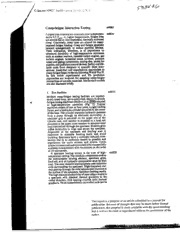Table Of ContentCreep-fatigue Interaction Testing
Fatigue livesinmetals arenominally time independent
below 0.5 To.,,. A: higher temperatures, fatigue lives
arealtered dueto rime-dependent, thermally activated
creep. Conversely, creep rates arealtered by super.
imposed fatigue loading. Creep and fatigue generally
interact synergistically to reduce material lifetime.
Their interaction, therefore, L_of £mpbrtanc_) to
structural durability of high-temperature structures
such asnuclear reactors, reusable rocket engines, gas
turbine engines, terrestrial steam turbines, pressure
vessel and piping components, castingdies, molds for
plastics, and pollution control devices. Safety and life-
cycle costs force designers to quantify these inter-
actions. Analytical and experimental approaches to
creep-fatigue began intheera following World War1I.
In this article experimental and life prediction
approaches ate reviewed for assessing creep-fatigue
interactions of metallic materials. Mechanistic models
are also discussed briefly.
1. I'estFacilities sx0015
Modern creep-fatigue testing facilities are sophisti-
cated closed-loospe,rvo-con_olled, electro-hydraulic
fatiguteestinmgachines('I-Ialfeotarld._ adapted
to high-temperature operation (Fig.---l_. Typical
machinesconsisotftwoorfourposts,arigidloading
frame, andahydraulic cylinder mounted in the center
ofthebase.Thecylindetrransmiths_'draulicpressure
from a pump throughan electromcscrvovalveA.
specimengripismounted on theupperend ofthe
cylinderram,andanotherisattachedtoa loadcell
mounted to the uppercross member to measure axial
loadtransmittetdhroughthespecimenM.odern grips
utilizheydraulictsoalignandsecurethespecimen.
Alignmentof thespecimenand loadingaxesis
importantto minimizebendingloadsand avoid
bucklingS.pecimenshaveauniformlyreducedcross-
sectionthatisasuniformlyheatedaspossiblaend
experiencesthecyclicstresseasnd strainsC.yclic
strains aremeasured and controlled withcommercially
availableextensometers withresolutioonnsthe order
of I0microstrain,
A specimenheatingsystemisthecoreofhigh- sx0020
temperature testing.Test machine components such as
the extensometer sensing element, specimen grips,
load cell, and all hydraulic components must bekept
cool.Themostversatile heating systemusesinduction
coilssurroundingthespecimen.High-frequenccyur.
rentpassingthroughthecoilisnduceseddycurrentast
the surfacoef the specimen. Specimen heating results.
The highthermalconductivity ofmost alloys results in
a specimen with minimal thermal gradients in the
radial direction. Coil spacing controls axial thermal
gradientTsh.reeindependentlcyontrollecdoilcsanbe
This report is apreprint of an article submitted to ajournal for
publication. Because of changes that may be made before formal
publication, this preprint is made available with the understanding
that it will not be cited or reproduced without the permission of the
author.
/
C:/jan/emr409037 Apr04-pro p lc- lm 3 _ 2)
i
i C
I
i/
Error Specimen_
Gain I
f I
[ .. ve ,o.v, I [
,(
Servovalve
|$
Figure 1
Modern creep-fatiguetesting machine.
employed to minimize the axial thermal gradient. Coil
spacing will allow visual observation of the specimen
and permits attachment of an extensonjgter sporting
ceramic extension rods that transmiq_gage section
displane.mmz_ to the more distant sensini[ element. A
thermocouple held in direct contact with the specimen
surface supplies feedback for temperature control.
Commercial noncontacfing optical pyrometers are
also available. Alternate heating techniques, such as a sxO025
combination of induction and radiation, are required
for low conductivity materials such as ceramics. A
small metallic susceptor surrounds the specimen and is
heated by induction. The susceptor then radiates heat
to the specimen. The low thermal mass of this system
permits reasonably fast temperature changes. Radi-
ation furnacesare quite common. They use coiled
Nichrome wire or siliconcarbideelementsor even
banks ofquartzlamps.Furnaces offerhighthermal
stability because of the large thermal mass, but are
slow to respond to intentional temperature changes
during thermomechanical testing. Direct resistance
heating also has been used successfully, but remains
uncommon. High current (low voltage) passed
/
C:/jan/emr409037 Apr04-pro p Ic-lm 4 (X 31
"_'.roughthe specimen results inseE-heating due tothe
specimen's electrical resistivity. This technique is the
=ost di_cult toconuolt_causeoftbe _l"enfly high
£_e:mal response. Heating of the test section does not
reiy on the thermal conductivity of the specimen;
cooling, however, does. Maintaining an accurate
constanttemperaturiesdilr_-ult.
Moderntestfacilities arctypicalilnyappropriatfoer _0030
long-term(_ 1month)testingL.essexpensivem,ore
reliabl¢, screw-driven machines aresul:_rioforr
purpose. If long-termcreep-fatigue resistanciesa
designrequirementl,ong-tertmestresultasrenecess-
ary to verifylifepredictiomnodels foraccurate
extrapolation.
2. MeehanDma and Life Prediction Modela sx0035
Fatigue crackinitiation and earlygrowth mechanisms
differ substantially from those for creep cracking.
Fatigue damage is time-lndependent to-and-fro crys-
tallographic slip, most evident atfree surfaces. Creep
damage occurs throughout the volume of stressed
material and requires the thermally activated diffusion
of atomic vacancies. Creep damage due to grain
boundary sliding, however, intersects free surfaces in
much thesameway as fatiguselip.
Theadditioonfcreeptoanotherwispeuretension/sx0040
compressionfatiguecyclecan be accomplishedin
threedistinctdliyfferenwtays asshown below.A
baselinceonditionofpurefatiguecyclingwillhave
negligiblcereeppresentifa highenough cyclic
frequency(_>IHz)isimposed.
- Constantstraininrgatelowenoughtointroduce
creepinadditiotnocrystallograpshliicp.
-Constantstresasscreepoccurswithtime.
- Constanttotalstrainwhilestressrelaxesc,on-
vertingelastitcocreepstrain(lefptanelsofFig.2).
Sinceanyoneofthesethreewaysofintroducingsx0045
creepintoacyclecouldbeappliedtotensiononly,
compressiononly,orbothtenslonandcompression,
thereemerge,intheextreme,onlyfourbasiccom-
binationosfcompletelryeversecdreep-fatigsuteress-
straicnycles:
-Tensileplastisctrai(np)reversebdycompressive
plastisctrai(np),i.e.(,pp)
-Tensileplastisctrai(np)reversebdycompressive
creepstrai(nc)i,.e.(,pc)
- Tensilecreepstrai(ne)reversedbycompressive
creepstrai(nc)i,.e.(,cp)
-Tensilecreepstrai(nc)reversedby compressive
plastisctrai(np),i.e.(,cc)
The rightpanelsofFig.2 illustrattyepicasltress-sx0050
strainhysteresilsoopsforstrainholdtypecycles.
Invariablcyreep-fatigcuyeclesinvolve(p.vs)training
inadditionto(cp),(pc),or (cc)components.Such
cyclesdemand useofservo-controllseydstemswith
extensometerasnd state-of-the-faurntctiongener-
/
C:/jan/emr409037 Apr04-pro p It- lm 5(X 4)
,',Slnm c,$1_u
,, .'
_.,\ / ", / ', , _
,:%/ :Y___.a'
/'qtarc2
Creep.fatigue testcycles.
ators. The cycles are simplifications of actual complex
service cycles. Experimental replication of service
histories would requirecomplex programming achiev-
able through a computer-controlled servo system.
Usually, life prediction models are reliedupon to link
single lah_,to_ ¢_e.s _th mlggi¢ se_,d¢.¢t'_,_.s.
The deformation, crack initiation, and earlygrowth sx0055
mechanisms, in general, will be different for each of
these discrete cycles. Schematic models developed
to illustrate these differences have been compared to
experimental observations for a variety of alloys
(Manson and Halford [I]_. Of the more than 100
creep-fatigue lifepredicuon models proposed since the
1950s,onlyabout10% havebeenapplieedxtensively
enoughtowarranttheirreview(Mille[r_ Halford
84
B2 et al._. The three most widely used-aTffthe time-
81 and cyc--'ffd-fractionrule (ASME _), strai_ange
partitioning (SLIP), and damage--_-echanics. Few
specitically address inevitable oxidation interactions.
The ASME Code Case is extremeIy conservative and
doesnotdirectlayddresswhenhilurewouldoccur.
Thatconditionisacceptablbeecausepowerplantsdo
nothavethesamestringenwteightandperformance
requirementass,forexample,aerospacepropulsion
..-_:.?.:_;.;_.:,.. , -" 7, .
v
I
C:[_an/emr409037 Apr04-pro p lc- lm 6 (X 5)
systems. The Inner require mtr.h g_mm:r life .1_
accuracy to conserve weight while m2,_._, z a
combination of durability and performance.
3. Co_ Re_ks Ix0060
Creep-fa6gue interactionisreasonablywelluader-
stood at thephenomeuological level.A sisni_:ant
short-termexperimentaldatabaseexistsand several
satisfactory analytic models are in use for estir_fing
cyclic lives. Modeling of oxldatioo interactlom with
creep-fatigue, lack oflong-term databases, and verified
long-term extrapolation procedures remain as im-
portant areas of research.
See also: Creep-Fatigue: Oxidation Interactions Creep-Fatigue: Oxidation Interactions
Biblioftaph¥
_'_ricaa SocietoyfMechaaical Engineers1986CodeCase/¢-
47-2$.ASME, NewYork
l:I'_ord GR, Lerch BA, McC_w MA 2000 Fatigue, ¢_-eep-
fatigue,andthermomechanicalfatiguelifetestingofalloys In:
(ed.}ASM Han_ook. Vol.8,MechanlcalTeJgln$and
Evaluation. ASMInternational, MaterialsPark, OH,Sect. 8B
a_l'_'nson SS, Halford GR 1984 Relation of cyclic loading
pattern to mlcrostmctural fracture in creep-fatigue In: CJ
Beevets (ed.) Proc. 2nd Int. Conf. Fatlfw and FaHfue
' Threzho!d_(Fatigue84). EngineeringMaterials AdvServLtd,
!QA: What is_,dv Serv! short for?
Wartey,UK, Vol. 3,pp.1237-55
l_[il]'erDA,PriestRH,EUisonEG 1984Areview of material
response and lifeprediction techniques under fatigue-creep
loadingconditions. HighTemp.Mater. Process. 6,155-94
G. R. Halford

